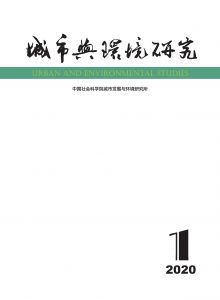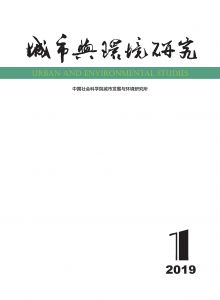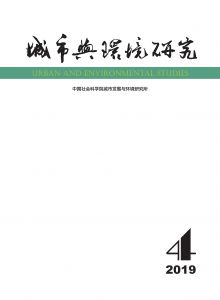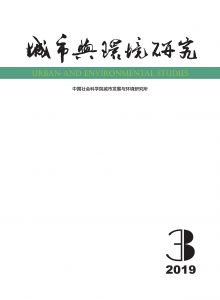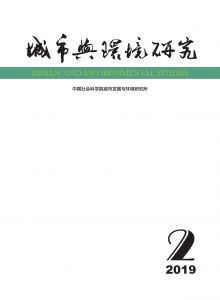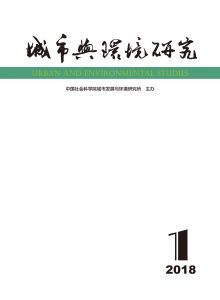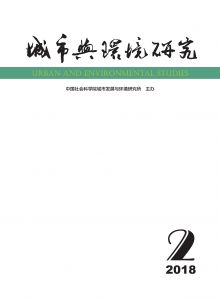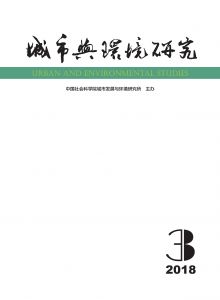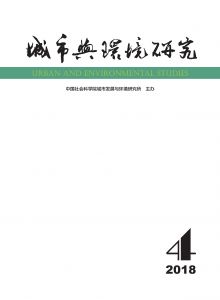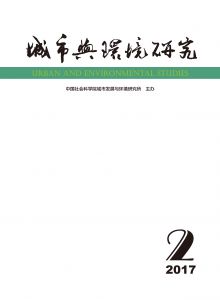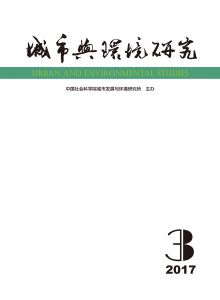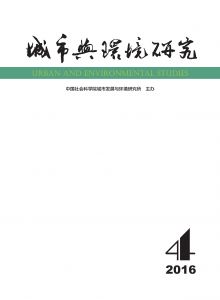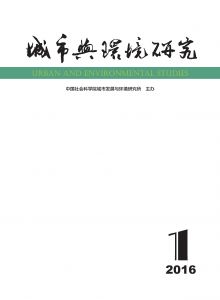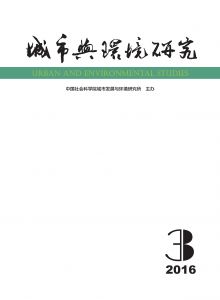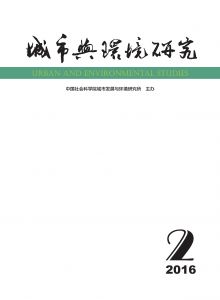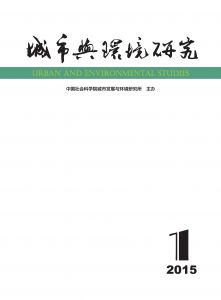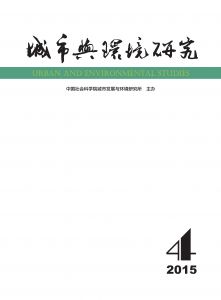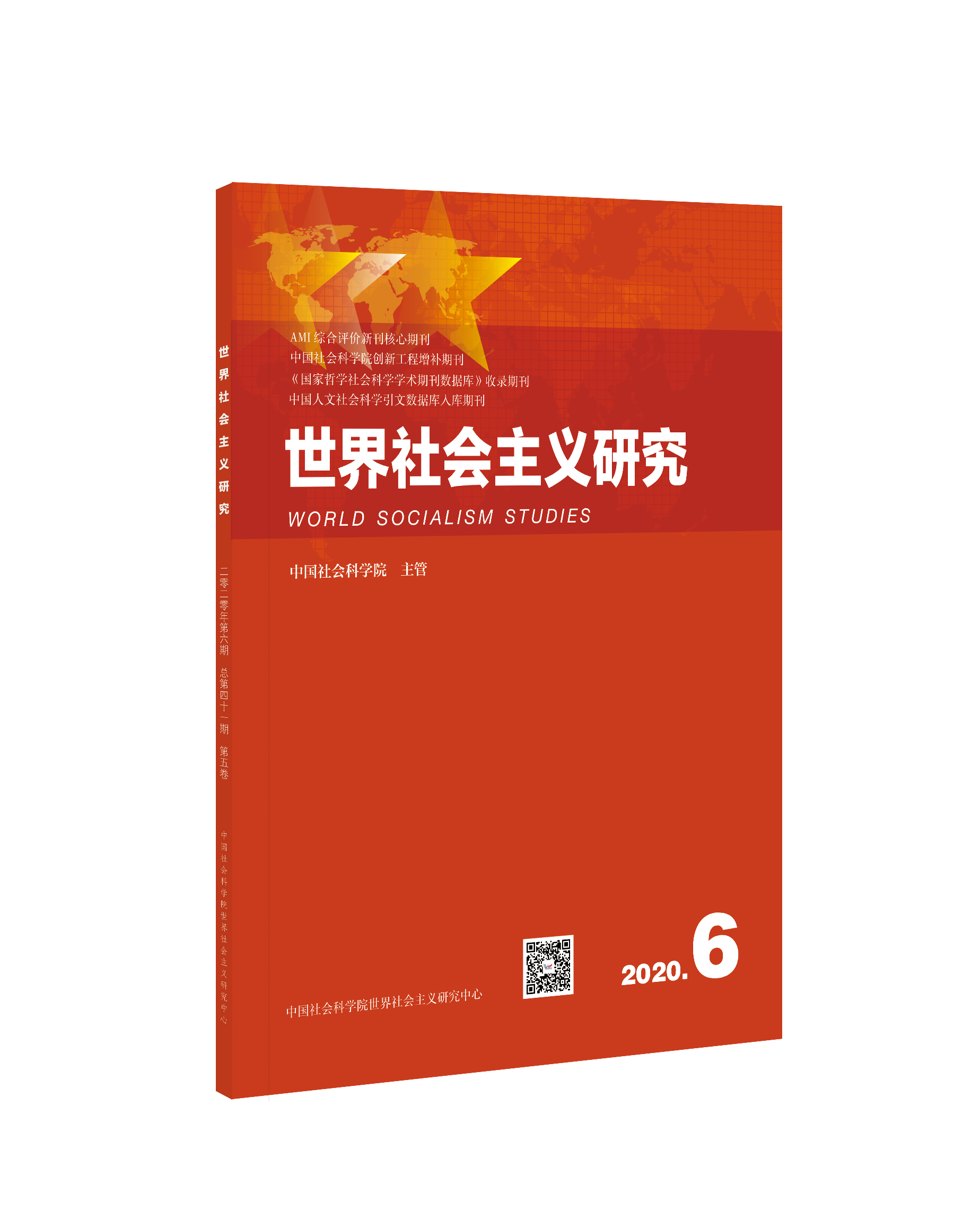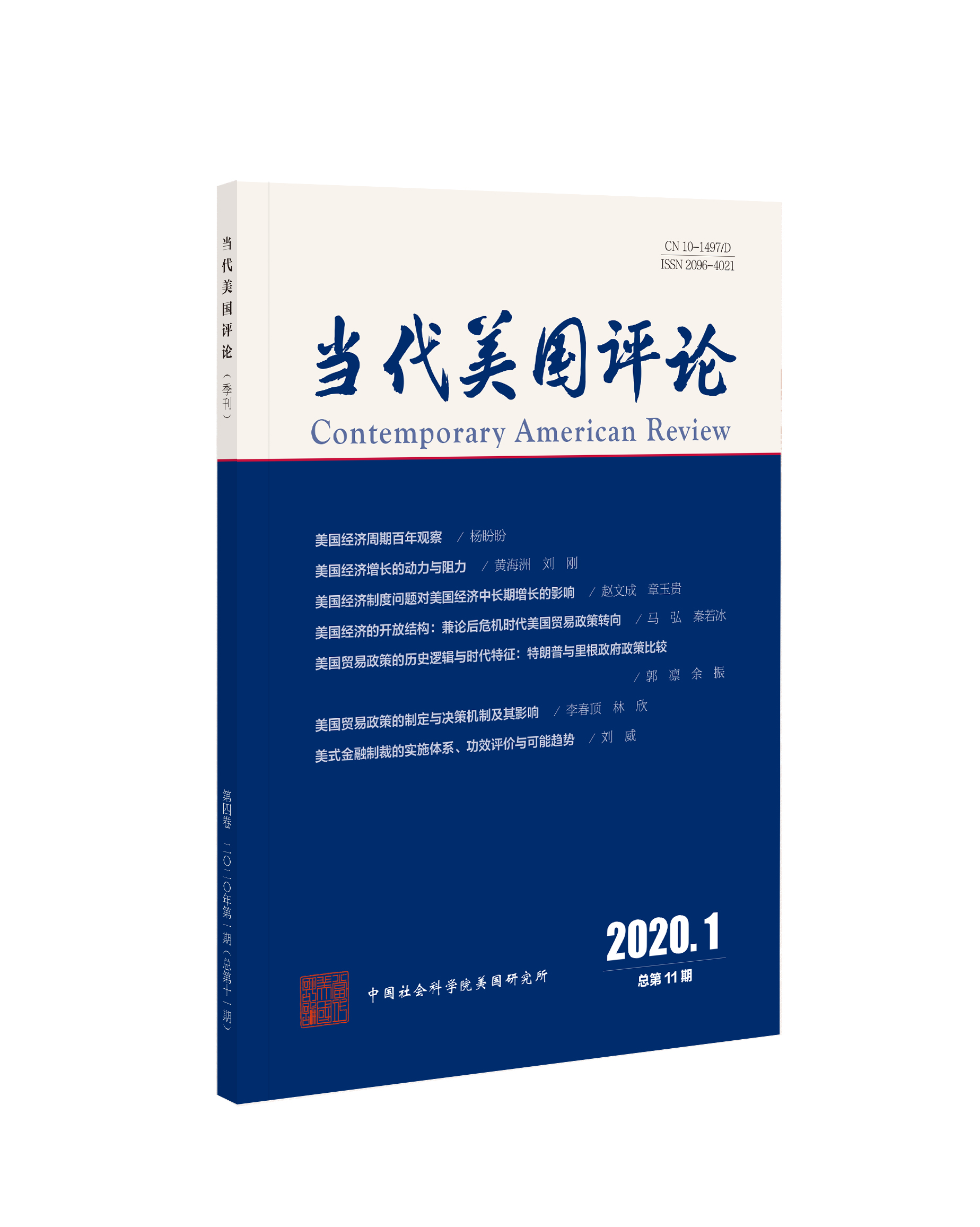最新期刊
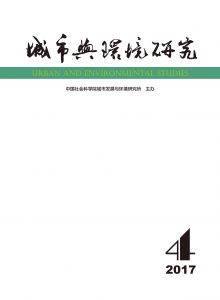
目录
过往期刊
参考文献
-
编委会
-
·学术论文·
-
中国大城市综合发展水平的层级与方阵
-
东北振兴战略是否促进了经济结构调整?
-
日本国土综合开发规划的历程、特征与启示
-
中国林业生态安全综合评估:基于时空格局分析
-
空气质量对股票投资行为影响的实证检验
-
-
·学术综述·
-
碳排放权交易的实践效果及其影响因素:一个文献综述
-
-
2017年总目录
-
投稿须知
-
版权页
按年份浏览:
- 全部
- 2020
- 2019
- 2018
- 2017
- 2016
- 2015
- 2014
[1][1]陈云松、吴青熹、张翼(2015):《近三百年中国城市的国际知名度——基于大数据的描述与回归》,《社会》第5期,第60~77页。
[2][2]付敏杰、赵春晓(2012):《中国地级市城市发展水平评估》,《云南财经大学学报》第5期,第61~69页。
[3][3]顾朝林(1992):《城市实力综合评价方法初探》,《地域研究与开发》第3期,第5~11页。
[4][4]柳建坤、吴愈晓、刘伟峰(2016):《中国城市国内知名度的变迁和机制——基于海量书籍和互联网搜索引擎的大数据分析》,《学术论坛》第6期,第113~121页。
[5][5]李倩倩、刘怡君、牛文元(2011):《城市空间形态和城市综合实力相关性研究》,《中国人口·资源与环境》第1期,第13~19页。
[6][6]李艳军、华民(2014):《中国城市经济的绿色效率及其影响因素研究》,《城市与环境研究》第1期,第36~52页。
[7][7]李佐军(2015):《中国经济发展面临八大新挑战》,《中国经济时报》11月2日。
[8][8]倪鹏飞、赵璧、魏劭琨(2013):《城市竞争力的指数构建与因素分析——基于全球500典型城市样本》,《城市发展研究》第6期,第72~79页。
[9][9]吴艳霞、张道宏(2005):《城市发展水平的综合评价及实证分析》,《经济与管理研究》第8期,第66~69页。
[10][10]周其仁(2016):《中国城市化的上一程和下一程》,《人民论坛》第5期,第70~71页。
[11][11]Jensen-Butler,C. (1999),“Cities in Competition”,Urban Studies ,36(5),pp.865-891.
[12][12]Rondinelli,D. A.,J. H. Johnson and J. D. Kasarda(1998),“The Changing Forces of Urban Economic Development:Globalization and City Competitiveness in the 21st Century”,Cityscape:A Journal of Policy Development and Research ,3(3),pp.71-105.
[13][13]Duffy,H. (1995),Competitive Cities ,London:Routledge Press,pp.29-36.
[14][14]Savitch,H. V. (2010),“What Makes a Great City Great?An American Perspective”,Cities ,27(1),pp.42-49.
[15][15]大野健一(2016):《产业政策的质量:中等收入陷阱的决定因素》,《比较》第6期,http://bijiao.caixin.com/2017-04-10/101076404.html[2017-06-23]。
[16][16]董艳梅、朱英明(2016):《高铁建设能否重塑中国的经济空间布局——基于就业、工资和经济增长的区域异质性视角》,《中国工业经济》第10期,第92~108页。
[17][17]干春晖、郑若谷、余典范(2011):《中国产业结构变迁对经济增长和波动的影响》,《经济研究》第5期,第4~16页。
[18][18]和军(2016):《东北振兴战略实施效果总体评价——基于2003~2014年增长率视角》,《辽宁大学学报(哲学社会科学版)》第6期,第36~43页。
[19][19]洪俊杰、刘志强、黄薇(2014):《区域振兴战略与中国工业空间结构变动——对中国工业企业调查数据的实证分析》,《经济研究》第8期,第28~40页。
[20][20]刘璟、袁诚(2012):《增值税转型改变了企业的雇佣行为吗?——对东北增值税转型试点的经验分析》,《经济科学》第1期,第103~114页。
[21][21]刘瑞明、赵仁杰(2015a):《国家高新区推动了地区经济发展吗?——基于双重差分方法的验证》,《管理世界》第8期,第30~38页。
[22][22]刘瑞明、赵仁杰(2015b):《西部大开发:增长驱动还是政策陷阱——基于PSM-DID方法的研究》,《中国工业经济》第6期,第32~43页。
[23][23]刘生龙、王亚华、胡鞍钢(2009):《西部大开发成效与中国经济收敛》,《经济研究》第9期,第94~104页。
[24][24]刘世锦(2011):《陷阱还是高墙?中国经济面临的真实挑战与战略选择》,北京:中信出版社。
[25][25]聂辉华、方明月、李涛(2009):《增值税转型对企业行为和绩效的影响》,《管理世界》第5期,第17~24、35页。
[26][26]菲利普·阿吉翁、蔡婧、马赛厄斯·德瓦特里庞等(2016):《产业政策和竞争》,《比较》第1期,http://bijiao.caixin.com/2016-03-16/100920867.html[2017-06-23]。
[27][27]盛广耀(2013):《东北振兴战略实施效果评析》,《社会科学辑刊》第2期,第94~102页。
[28][28]苏明政、徐佳信、张满林(2017):《东北振兴政策效果评估》,《上海经济研究》第4期,第112~117页。
[29][29]万海远、李实(2013):《户籍歧视对城乡收入差距的影响》,《经济研究》第9期,第43~55页。
[30][30]魏后凯(2008):《东北振兴政策的效果评价及思路》,《社会科学辑刊》第1期,第60~65页。
[31][31]魏后凯(2017):《东北经济的新困境及重振战略思路》,《社会科学辑刊》第1期,第26~32页。
[32][32]袁富华、张平、陆明涛(2015):《长期经济增长过程中的人力资本结构——兼论中国人力资本梯度升级问题》,《经济学动态》第5期,第11~22页。
[33][33]袁富华、张平、刘霞辉等(2016):《增长跨越:经济结构服务化、知识过程和效率模式重塑》,《经济研究》第10期,第12~26页。
[34][34]原毅军、谢荣辉(2014):《环境规制的产业结构调整效应研究——基于中国省际面板数据的实证检验》,《中国工业经济》第8期,第57~69页。
[35][35]詹姆斯·罗宾逊(2016):《产业政策和发展:政治经济学视角》,《比较》第1期,http://bijiao.caixin.com/2016-03-15/100920436.html[2017-06-23]。
[36][36]Busso,M.,J. Gregory and P. Kline(2013),“Assessing the Incidence and Efficiency of a Prominent Place Based Policy”,American Economic Review ,103(2),pp.897-947.
[37][37]Caliendo,M. and S.Kopeinig(2008),“Some Practical Guidance for the Implementation of Propensity Score Matching”,Journal of Economic Surveys ,22(1),pp.31-72.
[38][38]Dehejia,R.(2005),“Practical Propensity Score Matching:A Reply to Smith and Todd”,Journal of Econometrics ,125(1-2),pp.355-364.
[39][39]Glaeser,E. and J. Gottlieb(2008),“The Economics of Place-Making Policies”,Brookings Papers on Economic Activity ,39(1),pp.155-239.
[40][40]Heckman,J.J.,H.Ichimura and P.E.Todd(1997),“Matching as an Econometric Evaluation Estimator:Evidence from Evaluating a Job Training Program”,Review of Economic Studies ,64(4),pp.605-654.
[41][41]Heckman,J.J. and V. Edward(2001),“Policy-Relevant Treatment Effects”,American Economic Review ,91(2),pp.107-111.
[42][42]Heckman,J.J.,H. Ichimura and P.E.Todd(1998),“Matching as an Econometric Evaluation Estimator”,Review of Economic Studies ,65(2),pp.261-294.
[43][43]Kline,P.(2010),“Place Based Policies,Heterogeneity,and Agglomeration”,American Economic Review:Papers and Proceedings ,100(2),pp.383-387.
[44][44]Kline,P. and E. Moretti(2013),“People,Places,and Public Policy:Some Simple Welfare Economics of Local Economic Develoment Programs”,Social Science Electronic Publishing ,6(1),pp.629-662.
[45][45]Kline,P. and E. Moretti(2014),“Local Economic Development,Agglomeration Economies,and the Big Push:100 Years of Evidence from the Tennessee Valley Authority”,The Quarterly Journal of Economics ,129(1),pp.275-331.
[46][46]Partridge,M. D. and M. Betz(2013),“Country Road Take Me Home:Migration Patterns in the Appalachia America and Place-Based Policy”,International Regional Science Review ,36(3),pp.267-295.
[47][47]Reynolds,C. L. and S.Rohlin(2014),“Do Location-Based Tax Incentives Improve Quality of Life and Quality of Business Environment”,Journal of Regional Science ,54(1),pp.1-32.
[48][48]Rosenbaum,P.R. and D. B. Rubin(1983),“The Central Role of the Propensity Score in Observational Studies for Causal Effects”,Biometrika ,70(1),pp.41-55.
[49][49]Wang,J.(2013),“The economic impact of Special Economic Zones:Evidence from Chinese Municipalities”,Journal of Development Economics ,101(1),pp.133-147.
[50][50]包茂宏(2002):《日本环境公害及其治理的经验教训》,《中国党政干部论坛》第10期,第51~53页。
[51][51]蔡玉梅、顾林生、李景玉等(2008):《日本六次国土综合开发规划的演变及启示》,《中国土地科学》第6期,第76~80页。
[52][52]樊杰(2017):《我国空间治理体系现代化在“十九大”后的新态势》,《中国科学院院刊》第4期,第396~404页。
[53][53]〔日〕冈田知弘、川濑光义、铃木城等(1997):《国際化時代の地域経済学》,东京:有斐閣アルマ。
[54][54]〔日〕宫崎仁(1969):《新全国総合開発計画の解説》,东京:日本経済新聞社。
[55][55]郭四志(1987):《战后日本重化工业化》,《现代日本经济》第4期,第61~64页。
[56][56]郝庆、孟旭光、周璞(2012):《我国国土规划的发展历程与编制思路创新》,《科学》第3期,第42~45页。
[57][57]姜雅(2010):《日本的最新国土规划——国土形成规划》,《国土资源情报》第3期,第14~19页。
[58][58]赖深江(2010):《日本国土计划展开过程(1940~2000)之研究》,http://eportfolio.lib.ksu. edu.tw/user/4/9/4970T113/repository/A2-2.pdf[2017-07-04]。
[59][59]李龙云(1981):《日本的国土利用和地域开发》,《自然资源》第3期,第82~89页。
[60][60]凌强(2008):《日本政府主导型旅游发展模式及其政策措施与成效》,《世界地理研究》第3期,第150~157页。
[61][61]刘薇(2015):《PPP模式理论阐释及其现实例证》,《改革》第1期,第78~89页。
[62][62]陆大道(2001):《论区域的最佳结构与最佳发展——提出“点-轴系统”和“T”型结构以来的回顾与再分析》,《地理学报》第2期,第127~135页。
[63][63]陆大道(2015):《京津冀城市群功能定位及协同发展》,《地理科学进展》第3期,第265~270页。
[64][64]陆书至(1992):《日本全国综合开发的产生和效果》,《地理学与国土研究》第1期,第50~54页。
[65][65]毛汉英(2000):《日本第五次全国综合开发规划的基本思路及对我国的借鉴意义》,《世界地理研究》第1期,第105~112页。
[66][66]强海洋、兰平和、张宝龙(2012):《中国国土规划研究综述及展望》,《中国土地科学》第6期,第92~96页。
[67][67]日本国土交通省(2008):《国土形成計画(全国計画)》,http://www.mlit.go.jp/kokudoseisaku/kokudoseisaku_tk3_000082.html[2017-07-04]。
[68][68]日本国土交通省(2014):《国土のグランドデザイン2050~対流促進型国土の形成~》,http://www.mlit.go.jp/kokudoseisaku/kokudoseisaku_tk3_000043.html[2017-07-04]。
[69][69]日本国土厅计划调查局(1999):《21世紀の国土のグランドデザイン——新しい全国総合開発計画の解説》,东京:時事通信社。
[70][70]石敏俊(2017):《京津冀建设世界级城市群的现状、问题和方向》,《中共中央党校学报》第4期,第49~55页。
[71][71]〔日〕实清隆(1999):《国土開発政策の展開に関する研究》,《奈良大学紀要》第27期,第67~82页。
[72][72]童岩(1985):《日本正在制定第四次全国综合开发计划》,《现代日本经济》第5期,第59~60页。
[73][73]魏后凯(1988):《区域开发理论研究》,《地域研究与开发》第1期,第16~19页。
[74][74]吴殿廷、虞孝感、查良松等(2006):《日本的国土规划与城乡建设》,《地理学报》第7期,第771~780页。
[75][75]〔日〕伊东维年(1998):《テクノポリス政策の研究》,东京:日本評論社。
[76][76]翟振武、陈佳鞠、李龙(2016):《中国人口老龄化的大趋势、新特点及相应养老政策》,《山东大学学报(哲学社会科学版)》第3期,第27~35页。
[77][77]张季风(2013):《日本国土综合开发论》,北京:中国社会科学出版社。
[78][78]赵尚朴(1980):《关于日本的第三次全国综合开发计划》,《城市规划研究》第1期,第28~36页。
[79][79]〔日〕中村刚治郎、杨云峰、哈斯巴特尔(1989):《战后日本的国土整治的经验教训和第四次全国综合发展计划》,《地理科学进展》第2期,第19~23页。
[80][80]周尚意、张国友、徐香兰(2000):《日本新国土规划与地方规划的相互关系》,《地理研究》第4期,第400~406页。
[81][81]〔日〕综合政策研究会(1963):《日本の地域開発》,东京:ダイヤモンド社。
[82][82]Kawagoe,M. (1999),“Regional Dynamics in Japan:A Reexamination of Barro Regression”,Journal of the Japanese International Economics ,13(1),pp. 61-72.
[83][83]Kakamu,K. and M. Fukushige (2005),“Divergence or Convergence:Income Inequality between Cities,Towns and Villages in Japan”,Japan and the World Economy ,17(4),pp. 407-416.
[84][84]陈军纪、王蕾、刘彬等(2015):《极旱荒漠生态系统健康评价——以安西国家级自然保护区为例》,《干旱区资源与环境》第12期,第98~103页。
[85][85]郭海、陈文汇(2013):《我国现代林业评价指标体系设计研究》,《安徽农业科学》第13期,第5791~5793页。
[86][86]贾宝全、慈龙骏、高志海等(2001):《绿洲荒漠化及其评价指标体系的初步探讨》,《干旱区研究》第2期,第19~24页。
[87][87]刘心竹、米锋、张爽等(2014):《基于有害干扰的中国省域森林生态安全评价》,《生态学报》第11期,第3115~3127页。
[88][88]鲁莎莎、郭丽婷、陈英红等(2017):《北京市森林生态安全情景模拟与优化调控研究》,《干旱区地理》第4期,第787~794页。
[89][89]米锋、谭曾豪迪、顾艳红等(2015):《我国森林生态安全评价及其差异化分析》,《林业科学》第7期,第107~115页。
[90][90]汤旭、冯彦、鲁莎莎等(2018):《基于生态区位系数的湖北省森林生态安全评价及重心演变分析》,《生态学报》第3期,第1~14页。
[91][91]汪朝辉、吴楚材、成凤明(2009):《张家界国家森林公园生态安全管理模式探析》,《经济地理》第9期,第1580~1584页。
[92][92]王玺婧、吴秀芹、张宇清等(2012):《我国荒漠生态系统生物多样性生态地理分区》,《中国水土保持科学》第5期,第1~8页。
[93][93]魏彬、杨校生、吴明等(2010):《海岛林业生态安全评价》,《南京林业大学学报(自然科学版)》第4期,第161~164页。
[94][94]吴波、苏志珠、杨晓晖等(2005):《荒漠化监测与评价指标体系框架》,《林业科学研究》第4期,第490~496页。
[95][95]杨时民、李玉文、吕玉哲(2006):《扎龙湿地生态安全评价指标体系研究》,《林业科学》第5期,第127~132页。
[96][96]殷贺、李正国、王仰麟(2011):《荒漠化评价研究进展》,《植物生态学报》第3期,第345~352页。
[97][97]俞孔坚、李海龙、李迪华等(2009):《国土尺度生态安全格局》,《生态学报》第10期,第5163~5175页。
[98][98]赵其国、高俊峰(2007):《中国湿地资源的生态功能及其分区》,《中国生态农业学报》第1期,第1~4页。
[99][99]张频、张邦文、蔡海生等(2013):《江西省林业生态安全物元分析评价》,《江西农业大学学报》第4期,第791~797页。
[100][100]张升、戴广翠(2010):《绿色经济与林业发展》,《林业经济》第5期,第20~25页。
[101][101]张煜星(2017):《林业资源监测现状与技术》,《中国机构改革与管理》第3期,第40~42页。
[102][102]张运、张贵(2012):《洞庭湖湿地生态系统服务功能效益分析》,《中国农学通报》第8期,第276~281页。
[103][103]张智光(2013):《基于生态—产业共生关系的林业生态安全测度方法构想》,《生态学报》第4期,第1326~1336页。
[104][104]张志涛(2011):《从系统论观点认识和思考现代林业》,《中南林业科技大学学报(社会科学版)》第4期,第78~80页。
[105][105]朱卫红、苗承玉、郑小军等(2014):《基于3S技术的图们江流域湿地生态安全评价与预警研究》,《生态学报》第6期,第1379~1390页。
[106][106]邹长新、陈金林、李海东(2012):《基于模糊综合评价的若尔盖湿地生态安全评价》,《南京林业大学学报(自然科学版)》第3期,第53~58页。
[107][107]Guan,Q.,W. Guan and J. Yang,et al. (2017),“Spatial and Temporal Changes in Desertification in the Southern Region of the Tengger Desert from 1973 to 2009”,Theoretical and Applied Climatology ,129(1-2),pp.487-502.
[108][108]Ji,W. (2007),Wetland and Water Resource Modeling and Assessment:A Watershed Perspective ,Hoboken:CRC Press of Taylor & Francis Group.
[109][109]Karr,J. R. (1981),“Assessment of Biotic Integrity Using Fish Communities”,Fisheries ,6(6),pp.21-27.
[110][110]Li,F.,S. S.Lu and Y. Sun,et al. (2015),“Integrated Evaluation and Scenario Simulation for Forest Ecological Security of Beijing Based on System Dynamics Model”,Sustainability ,7(10),pp.13631-13659.
[111][111]Li,Q.,C. Zhang and Y. Shen,et al. (2016),“Developing Trend of Aeolian Desertification in China’s Tibet Autonomous Region from 1977 to 2010”,Environmental Earth Sciences ,75(10),pp.1-12.
[112][112]Han,M.(2010),“Healthy Evaluation for Wetlands Based on Vague Mathematics:Taking the Wetlands on Laizhou Bay’s Coastal Plain of China as a Case”,Procedia Environmental Sciences ,2(2),1491-1500.
[113][113]Maingi,J. K. and S. E. Marsh (2001),“Assessment of Environmental Impacts of River Basin Development on the Riverine Forests of Eastern Kenya Using Multi-Temporal Satellite Data”,International Journal of Remote Sensing ,22(14),pp.2701-2729.
[114][114]Olsson,L. (1985),“An Integrated Study of Desertification:Applications of Remote-Sensing,GIS and Spatial Models in Semiarid Sudan”,Lund Studies in Geography. Ser. C General and Mathematical Geography ,13,pp.159-170.
[115][115]Zhang,J. and J. Gao(2016),“Lake Ecological Security Assessment Based on SSWSSC Framework from 2005 to 2013 in an Interior Lake Basin,China”,Environmental Earth Sciences ,75(10),pp.1-11.
[116][116]常桂秋、王灵菇、潘小川(2003):《北京市大气污染物与儿科门急诊就诊人次关系的研究》,《中国校医》第4期,第295~297页。
[117][117]陈彦斌(2005):《情绪波动和资产价格波动》,《经济研究》第3期,第36~45页。
[118][118]戴海夏、宋伟民、高翔等(2004):《上海市A城区大气PM10 、PM2.5 污染与居民日死亡数的相关分析》,《卫生研究》第3期,第293~297。
[119][119]郭永济、张谊浩(2016):《空气质量会影响股票市场吗?》,《金融研究》第2期,第71~85页。
[120][120]蒋玉梅、王明照(2010):《投资者情绪与股票收益:总体效应与横截面效应的实证研究》,《南开管理评论》第3期,第150~160页。
[121][121]井立滨、秦怡、徐肇翊等(2000):《本溪市大气污染与急慢性呼吸系统疾病的关系》,《环境与健康杂志》第5期,第268~270页。
[122][122]陆静(2011):《中国股票市场天气效应的实证研究》,《中国软科学》第6期,第65~78页。
[123][123]马洪宝、洪传洁(1992):《大气颗粒物污染对慢性呼吸道疾病的影响》,《中国公共卫生学报》第4期,第229~232页。
[124][124]山立威(2011):《心理还是实质:汶川地震对中国资本市场的影响》,《经济研究》第4期,第121~146页。
[125][125]王美今、孙建军(2004):《中国股市收益、收益波动与投资者情绪》,《经济研究》第10期,第75~83页。
[126][126]伍燕然、韩立岩(2007):《不完全理性、投资者情绪与封闭式基金之谜》,《经济研究》第3期,第117~129页。
[127][127]杨炘、王小征、滕召学(2004):《中国股市个人与机构投资者的羊群效应》,《清华大学学报(自然科学版)》第 12期,第 1610~1614 页。
[128][128]余佩琨、钟瑞军(2009):《个人投资者情绪能预测市场收益率吗》,《南开管理评论》第1期,第96~101页。
[129][129]周燕荣、曾庆、徐放(1997):《重庆地区大气污染与住院病人动态的相关性分析》,《现代预防医学》第1期,第43~45页。
[130][130]Banerjee,A.V.(1992),“A Simple Model of Herd Behavior”,Quarterly Journal of Economics ,107(3),pp.797-817.
[131][131]Cao,M. and J. Wei. (2005),“Stock Market Returns:A Note on Temperature Anomaly”,Journal of Banking and Finance ,29(6),pp.1559-1573.
[132][132]Chang,T.,J. G.Zivin and T. Gross,et al. (2016a),“Particulate Pollution and the Productivity of Pear Packers”,American Economic Journal:Economic Policy ,8(3),pp.141-169.
[133][133]Chang,T.,J.G.Zivin and T. Gross,et al. (2016b),“The Effect of Pollution on Worker Productivity:Evidence from Call-center Workers in China”,NBER Working Paper ,#22328.
[134][134]Clarke,D. and L. Sokoloff (1999),“Circulation and Energy Metabolism of the Brain”,in G. J. Siegel,et al. (eds.),Basic Neurochemistry ,Philadelphia:Lippincott-Raven,pp.637-669.
[135][135]Cooke,L.,M.S. Rose and W. J.Becker (2000),“Chinook Winds and Migrane Headache”,Neurology ,54(2),pp.302-307.
[136][136]Coudert,V. and M. Gex (2008),“Does Risk Aversion Drive Financial Crises?Testing the Predictive Power of Empirical Indicators”,Journal of Empirical Finance ,15(2),pp.167-184.
[137][137]Dockery,D. W. and C. A. Pope (1994),“Acute Respiratory Effects of Particulate Air Pollution”,Annual Review of Public Health ,15(1),pp. 107-132.
[138][138]Genc,S.,Z. Zadeoglulari and S. H. Fuss,et al. (2012),“The Adverse Effects of Air Pollution on the Nervous System”,Journal of Toxicology ,pp.1-23.
[139][139]Ghio,A. J.,C. Kim and R. B. Devlin (2000),“Concentrated Ambient Air Particles Induce Mild Pulmonary Inflammation in Healthy Human Volunteers”,American Journal of Respiratory and Critical Care Medicine ,162 (3),pp.981-988.
[140][140]Greenstone,M.,J. A. List and C. Syverson (2012) “The Effects of Environmental Regulation on the Competitiveness of U.S. Manufacturing”,American Economic Review ,93(2),pp.431-435.
[141][141]Grossman,M. (1972),“On the Concept of Health Capital and the Demand for Health”,Journal of Political Economy ,80 (2),pp. 223-255.
[142][142]Hausman,J.A.,B. D. Ostro and D. A. Wise (1984),“Air Pollution and Lost Work”,NBER Working Paper ,#1263.
[143][143]Heyes,A.,M. Neidell,and S. Saberian(2016),“The Effect of Air Pollution on Investor Behavior:Evidence from the S&P 500”,National Bureau of Economic Research ,#22753.
[144][144]Hirshleifer,D. and T. Shumway (2003),“Good Day Sunshine:Stock Returns and The Weather”,Journal of Finance ,58 (3),pp. 1009-1032.
[145][145]Kampa,M. and E. Castanas (2008),“Human Health Effects of Air Pollution”,Environmental Pollution ,151(2),pp. 362-367.
[146][146]Kamstra,M. J.,L. A. Kramer and M. D. Levi (2002),“Losing Sleep at the Market:The Daylight-savings Anomaly”,American Economic Review ,92(4),pp. 1257-1263.
[147][147]Kamstra,M. J.,L. A. Kramer and M. D. Levi (2003),“Winter Blues:A SAD Stock Market Cycle”,American Economic Review ,93(1),pp. 324-343.
[148][148]Keef,S. P. and M. L. Roush (2005),“Influence of Weather on New Zealand Financial Securities”,Accounting and Finance ,45,pp. 415-437.
[149][149]Lavy,V.,A. Ebenstein and S. Roth (2014),“The Impact of Short Term Exposure to Ambient Air Pollution on Cognitive Performance and Human Capital Formation”,NBER Working Paper ,#20648.
[150][150]Loewenstein,G. (2000),“Emotions in Economic Theory and Economic Behavior”,American Economic Review ,90(2),pp. 426- 432.
[151][151]Loewenstein,G.F.,E. U.Weber and C. Hsee,et al. (2001),“Risk as Feelings”,Psychological Bulletin ,127(2),pp. 267- 286.
[152][152]Nastos,P. T.,A. G. Paliatsos and V. P. Tritakis,et al. (2006),“Environmental Discomfort and Geomagnetic Field Influence on Psychological Mood in Athens,Greece”,Indoor and Built Environment ,15(4),pp. 365-372.
[153][153]Ostro,B. D. (1983),“The Effects of Air Pollution on Work Loss and Morbidity”,Journal of Environmental Economics and Management ,10(4),pp. 371-382.
[154][154]Peters,E. and P. Slovic (2000),“The Springs of Action:Affective and Analytical Information Processing in Choice”,Personality and Social Psychology Bulletin ,26(12),pp. 1465-1475.
[155][155]Pope Ⅲ,C. A. (2000),“Epidemiology of Fine Particulate Air Pollution and Human Health:Biologic Mechanisms and who is at Risk?”,Environmental Health Perspectives ,108(4),pp. 713-723.
[156][156]Pope Ⅲ,C. A. and D. W. Dockery (2006),“Health Effects of Fine Particulate Air Pollution:Lines that Connect”,Journal of the Air and Waste Management Association ,56(6),pp.709-742.
[157][157]Saunders,E. M. (1993),“Stock Prices and Wall Street Weather”,American Economic Review ,83(5),pp.1337-1345.
[158][158]Seaton,A.,D. Godden and W. MacNee (1995),“Particulate Air Pollution and Acute Health Effects”,Lancet ,345 (8943),pp.176-178.
[159][159]Thatcher,T. L. and D. W. Layton (1995),“Deposition,Resuspension and Penetration of Particles Within a Residence”,Atmospheric Environment ,29 (13),pp.1487-1497.
[160][160]Vette,A. F.,A. Rea and P. Lawless,et al.(2001),“Characterization of Indoor-outdoor Aerosol Concentration Relationships During the Fresno PM Exposure Studies”,Aerosol Science and Technology ,34(1),pp.118-126.
[161][161]Whaley,R. E. (2009),“Understanding the VIX”,Journal of Portfolio Management ,35(3),pp.98-105.
[162][162]Zivin,J. G. and M. J. Neidell (2011),“The Impact of Pollution on Worker Productivity”,NBER Working Paper ,102(7),pp. 3652-3673.
[163][163]安崇义、唐跃军(2012):《排放权交易机制下企业碳减排的决策模型研究》,《经济研究》第8期,第45~58页。
[164][164]陈占锋、刘通凡、殷方超等(2013):《中国区域碳强度目标设定的情景分析——以北京市为例》,《北京理工大学学报:社会科学版》第5期,第16~22页。
[165][165]崔连标、范英、朱磊等(2013):《碳排放交易对实现我国“十二五”减排目标的成本节约效应研究》,《中国管理科学》第1期,第37~46页。
[166][166]高鹏飞、陈文颖(2002):《碳税与碳排放》,《清华大学学报(自然科学版)》第10期,第1335~1338页。
[167][167]胡民(2006):《基于交易成本理论的排污权交易市场运行机制分析》,《理论探讨》第5期,第83~85页。
[168][168]李寿德、胡越峰、顾孟迪等(2010):《基于排污权交易的环境政策对厂商污染治理技术进步的激励分析》,《系统管理学报》第5期,第491~496页。
[169][169]林海平(2011):《区域排污权交易市场的交易成本研究》,《现代管理科学》第7期,第109~111页。
[170][170]刘楠峰、范莉莉、陈肖琳(2017):《碳交易机制下以技术投入为导向的边际减排成本曲线研究——以水泥、火电、煤炭和钢铁行业为例》,《中国科技论坛》第7期,第57~63页。
[171][171]罗智霞(2014):《碳排放权交易定价研究综述》,《技术经济与管理研究》第10期,第77~81页。
[172][172]马艳艳、王诗苑、孙玉涛(2013):《基于供求关系的中国碳交易价格决定机制研究》,《大连理工大学学报(社会科学版)》第3期,第42~46页。
[173][173]潘家华(2016):《碳排放交易体系的构建、挑战与市场拓展》,《中国人口·资源与环境》第8期,第1~5页。
[174][174]史丹、吴利学、傅晓霞等(2008):《中国能源效率地区差异及其成因研究——基于随机前沿生产函数的方差分解》,《管理世界》第2期,第35~43页。
[175][175]石敏俊、袁永娜、周晟吕等(2013):《碳减排政策:碳税、碳交易还是两者兼之?》,《管理科学学报》第9期,第9~19页。
[176][176]孙睿、况丹、常冬勤(2014):《碳交易的“能源—经济—环境”影响及碳价合理区间测算》,《中国人口·资源与环境》第7期,第82~90页。
[177][177]涂正革、谌仁俊(2015):《排污权交易机制在中国能否实现波特效应?》,《经济研究》第7期,第160~173页。
[178][178]王璐犀(2012):《欧盟碳交易体系的实践及经济学分析》,《世界华商经济年鉴:理论版》,第5~6页。
[179][179]隗斌贤、揭筱纹(2012):《基于国际碳交易经验的长三角区域碳交易市场构建思路与对策》,《管理世界》第2期,第175~176页。
[180][180]吴力波、钱浩祺、汤维祺(2014):《基于动态边际减排成本模拟的碳排放权交易与碳税选择机制》,《经济研究》第9期,第48~61页。
[181][181]熊灵、齐绍洲(2012):《欧盟碳排放交易体系的结构缺陷、制度变革及其影响》,《欧洲研究》第1期,第51~64页。
[182][182]徐瑾、万威武(2002):《交易成本与排污权交易体系的设计》,《中国软科学》第7期,第115~118页。
[183][183]宣晓伟、张浩(2013):《碳排放权配额分配的国际经验及启示》,《中国人口·资源与环境》第12期,第10~15页。
[184][184]俞业夔、李林军、李文江等(2014):《中国碳减排政策的适用性比较研究——碳税与碳交易》,《生态经济(中文版)》第5期,第77~81页。
[185][185]曾刚、万志宏(2009):《国际碳交易市场:机制、现状与前景》,《中国金融》第24期,第48~50页。
[186][186]曾刚、万志宏(2010):《碳排放权交易:理论及应用研究综述》,《金融评论》第4期,第54~67页。
[187][187]张成、周波、吕慕彦(2015):《履行哥本哈根会议的碳生产率承诺——顺理成章抑或凤凰涅槃》,《南京财经大学学报》第6期,第7~11页。
[188][188]张成、史丹、李鹏飞(2017):《中国实施省际碳排放权交易的潜在成效》,《财贸经济》第2期,第93~108页。
[189][189]张健、廖胡、梁钦锋等(2009):《碳税与碳排放权交易对中国各行业的影响》,《现代化工》第6期,第77~82页。
[190][190]张晓梅、庄贵阳(2015):《中国省际区域碳减排差异问题的研究进展》,《中国人口·资源与环境》第2期,第135~143页。
[191][191]张亚雄、李继峰、冯婷婷(2011):《我国2020年碳强度目标省级分解方法研究》,《财经界》第2期,第36~40页。
[192][192]赵海霞(2006):《试析交易成本下的排污权交易的最优化设计》,《环境科学与技术》第5期,第45~47页。
[193][193]郑立群(2012):《中国各省区碳减排责任分摊——基于零和收益DEA模型的研究》,《资源科学》第11期,第2087~2096页。
[194][194]钟小剑、黄晓伟、范跃新等(2017):《中国碳交易市场的特征、动力机制与趋势——基于国际经验比较》,《生态学报》第1期,第331~340页。
[195][195]周县华、范庆泉(2016):《碳强度减排目标的实现机制与行业减排路径的优化设计》,《世界经济》第7期,第168~192页。
[196][196]Abrell,J.,A. N. Faye and G. Zachmann (2011),“Assessing the Impact of the EU ETS Using Firm Level Data”,Bruegel Working Paper .
[197][197]Alberola,E.,J. Chevallier and B. Chèze (2008),“The EU Emissions Trading Scheme:Disentangling the Effects of Industrial Production and CO2 Emissions on Carbon Prices”,Social Science Electronic Publishing ,116(4),pp. 93-126.
[198][198]Aldy,J. E.,A. J. Krupnick and R. G. Newell,et al. (2010),“Designing Climate Mitigation Policy”,Journal of Economic Literature ,48(4),pp. 903-934.
[199][199]Ang,B. W. and F. Q. Zhang (1999),“Inter-regional Comparisons of Energy-related CO2 ,Emissions Using the Decomposition Technique”,Energy ,24(4),pp. 297-305.
[200][200]Anger,N. and U.Oberndorfer(2008),“Firm Performance and Employment in the EU Emissions Trading Scheme:An Empirical Assessment for Germany”,Energy Policy ,36(1),pp.12-22.
[201][201]Bai,Q. and M. Chen (2016),“The Distributionally Robust Newsvendor Problem with Dual Sourcing under Carbon Tax and Cap-and-Trade Regulations”,Computers & Industrial Engineering ,98(4),pp. 260-274.
[202][202]Bakam,I.,B. B. Balana and R. Matthews (2012),“Cost-effectiveness Analysis of Policy Instruments for Greenhouse Gas Emission Mitigation in the Agricultural Sector”,Journal of Environmental Management ,112(24),pp. 33-44.
[203][203]Barreto,L. and S. Kypreos (2004),“Emissions Trading and Technology Deployment in an Energy-systems ‘Bottom-up’ Model with Technology Learning”,European Journal of Operational Research ,158(1),pp. 243-261.
[204][204]Benz,E. and S. Trück (2009),“Modeling the Price Dynamics of CO2 Emission Allowances”,Energy Economics ,31(1),pp. 4-15.
[205][205]Böhringer,C.,B. Dijkstra and K. E. Rosendahl (2014),“Sectoral and Regional Expansion of Emissions Trading”,Resource & Energy Economics ,37(1),pp. 201-225.
[206][206]Borghesi,S.,G. Cainelli and M. Mazzanti (2015),“Linking Emission Trading to Environmental Innovation:Evidence from the Italian Manufacturing Industry”,Research Policy ,44(3),pp. 669-683.
[207][207]Burniaux,J. M.,J. P. Martin and G. Nicoletti,et al. (1992),“GREEN a Multi-Sector,Multi-Region General Equilibrium Model for Quantifying the Costs of Curbing CO2 Emissions”,OECD Economics Department Working Papers .
[208][208]Cason,T. N. and L. Gangadharan (2003),“Transactions Costs in Tradable Permit Markets:An Experimental Study of Pollution Market Designs”,Journal of Regulatory Economics ,23(2),pp. 145-165.
[209][209]Chang,K.,C. Zhang and H. Chang (2016),“Emissions Reduction Allocation and Economic Welfare Estimation through Interregional Emissions Trading in China:Evidence from Efficiency and Equity”,Energy ,113(1),pp. 1125-1135.
[210][210]Coase,R. H. (1960),“The Problem of Social Cost”,Classic Papers in Natural Resource Economics ,56 (4),pp. 837-877.
[211][211]Cong,R. G. and Y. M. Wei (2010),“Potential Impact of (CET) Carbon Emissions Trading on China’s Power Sector:A Perspective from Different Allowance Allocation Options”,Energy ,35(9),pp. 3921-3931.
[212][212]Convery,F.J. and L. Redmand(2007),“Market and Price Developments in the European Union Emissions Trading Scheme”,Review of Environmental Economics & Policy ,1(1),pp.88-111.
[213][213]Crassous,R.,J. C. Hourcade and O. Sassi (2006),“Endogenous Structural Change and Climate Targets Modeling Experiments with Imaclim-R”,The Energy Journal ,27 (4),pp. 259-276.
[214][214]Criqui,P.,S. Mima and L. Viguier (1999),“Marginal Abatement Costs of CO2 ,Emission Reductions,Geographical Flexibility and Concrete Ceilings:An Assessment Using the POLES Model”,Energy Policy ,27(10),pp. 585-601.
[215][215]Crocker,T. D. (1966),“The Structuring of Atmospheric Pollution Control Systems”,Economics of Air Pollution ,29(2),pp. 288.
[216][216]Cui,L. B.,Y. Fan and L. Zhu,et al. (2014),“How Will the Emissions Trading Scheme Save Cost for Achieving China’s 2020 Carbon Intensity Reduction Target?”,Applied Energy ,136(12),pp. 1043-1052.
[217][217]Dai,H.,T. Masui and Y. Matsuoka,et al. (2011),“Assessment of China’s Climate Commitment and Non-fossil Energy Plan towards 2020 Using Hybrid AIM/CGE Model”,Energy Policy ,39(5),pp. 2875-2887.
[218][218]Dales,J. H. (1968),“Land,Water,and Ownership”,Canadian Journal of Economics ,1(4),pp. 791-804.
[219][219]De Perthuis,C. and R. Trotignon (2014),“Governance of CO2 Markets:Lessons from the EU ETS”,Energy Policy ,75,pp. 100-106.
[220][220]Demailly,D. and P. Quirion (2008),“European Emission Trading Scheme and Competitiveness:A Case Study on the Iron and Steel Industry”,Energy Economics ,30(4),pp. 2009-2027.
[221][221]Dewees,D. N. (2001),“Emissions Trading:ERCs or Allowances?”,Land Economics ,77(4),pp. 513-526.
[222][222]Egenhofer,C. (2007),“The Making of the EU Emissions Trading Scheme:Status,Prospects and Implications for Business”,European Management Journal ,25(6),pp. 453-463.
[223][223]Ellerman,D. A.,B. K. Buchner and C. Carraro (2007),“Allocation in the European Emissions Trading Scheme:Rights,Rents and Fairness”,Economics Papers from University Paris Dauphine ,43 (1),pp. 69-79.
[224][224]Fischer,C. (2001),Rebating Environmental Policy Revenues:Output-Based Allocations and Tradable Performance Standards ,Washington,DC:Resources for the Future.
[225][225]Fischer,C.,I. W. H. Parry and W. A. Pizer (2003),“Instrument Choice for Environmental Protection when Technological Innovation is Endogenous”,Environmental Economics and Management ,45(3),pp. 523-545.
[226][226]Fowlie,M. (2008),“Distributing Pollution Rights in Cap-and-Trade Programs:Are Outcomes Independent of Allocation?”,Review of Economics & Statistics ,95(6),pp. 1640-1652.
[227][227]Gagelmann,F. (2008),The Influence of the Allocation Method on Market Liquidity,Volatility and Firms’ Investment Decisions,Emissions Trading ,New York:Springer New York.
[228][228]Gangadharan,L. (2000),“Transaction Costs in Pollution Markets:An Empirical Study”,Land Economics ,76(4),pp. 601-614.
[229][229]Garbaccio,R. F.,M. S. Ho and D. W. Jorgenson (1999),“Controlling Carbon Emissions in China”,Environment and Development Economics ,4(4),pp. 493-518.
[230][230]Gottinger,H. W. (1998),“Greenhouse Gas Economics and Computable General Equilibrium”,Journal of Policy Modeling ,20(5),pp. 537-580.
[231][231]Hahn,R. W. (1984),“Market Power and Transferable Property Rights”,The Quarterly Journal of Economics ,99(4),pp. 753-765.
[232][232]Hoffmann,V. H. (2007),“EU ETS and Investment Decisions:The Case of the German Electricity Industry”,European Management Journal ,25(6),pp. 464-474.
[233][233]Hübler,M.,S. Voigt and A. Löschel (2014),“Designing an Emissions Trading Scheme for China—An Up-to-date Climate Policy Assessment”,Energy Policy ,75(6),pp. 57-72.
[234][234]Jung,C.,K. Krutilla and R. Boyd (1996),“Incentives for Advanced Pollution Abatement Technology at the Industry Level:An Evaluation of Policy Alternatives”,Journal of Environmental Economics and Management ,30(1),pp. 95-111.
[235][235]Kara,M.,S. Syri and A. Lehtilä,et al. (2008),“The Impacts of EU CO2 Emissions Trading on Electricity Markets and Electricity Consumers in Finland”,Energy Economics ,30(2),pp. 193-211.
[236][236]Keohane,N. O. (2009),“Cap-and-Trade,Rehabilitated:Using Tradable Permits to Control US Greenhouse Gases”,Review of Environmental Economics and Policy ,3 (1),pp. 42-62.
[237][237]Klaassen,G.,A. Nentjes and M. Smith (2005),“Testing the Theory of Emissions Trading:Experimental Evidence on Alternative Mechanisms for Global Carbon Trading”,Ecological Economics ,53(1),pp. 47-58.
[238][238]Lee,C. F.,S. J. Lin and C. Lewis (2008),“Analysis of the Impacts of Combining Carbon Taxation and Emission Trading on Different Industry Sectors”,Energy Policy ,36(2),pp. 722-729.
[239][239]Liao,C. N.,H. Önal and M. H. Chen (2009),“Average Shadow Price and Equilibrium Price:A Case Study of Tradable Pollution Permit Markets”,European Journal of Operational Research ,196(3),pp. 1207-1213.
[240][240]Lund,P. (2007),“Impacts of EU Carbon Emission Trade Directive on Energy-intensive Industries—Indicative Micro-economic Analyses”,Ecological Economics ,63(4),pp. 799-806.
[241][241]Lutz,C.,B. Meyer and C. Nathani,et al. (2005),“Endogenous Technological Change and Emissions:the Case of the German Steel Industry”,Energy Policy ,33(9),pp. 1143-1154.
[242][242]Malik,A. S. (1992),“Enforcement Costs and the Choice of Policy Instruments for Controlling Pollution”,Economic Inquiry ,30(4),pp. 714-721.
[243][243]Malueg,D. A. (1989),“Emission Credit Trading and the Incentive to Adopt New Pollution Abatement Technology”,Journal of Environmental Economics & Management ,16(1),pp. 52-57.
[244][244]Mandell,S. (2008),“Optimal Mix of Emissions Taxes and Cap-and-Trade”,Journal of Environmental Economics and Management ,56(2),pp. 131-140.
[245][245]Marshall,C. M. B. (1998),Economic Instruments and the Business Use of Energy,Report to Chancellor of the Exchequer,HM ,London:Treasury.
[246][246]McKibbin,W. J. and P. J. Wilcoxen (2002),Climate Change Policy after Kyoto:Blueprint for a Realistic Approach ,Washington D.C.:Brookings Institution Press.
[247][247]Meleo,L. (2014),“On the Determinants of Industrial Competitiveness:The European Union Emission Trading Scheme and the Italian Paper Industry”,Energy Policy ,74,pp. 535-546.
[248][248]Milliman,S. R. and R. Prince (1992),“Firm Incentive to Promote Technological Change in Pollution Control:Reply”,Journal of Environmental Economics and Management ,22(3),pp. 292-296.
[249][249]Montgomery,W. D. (1972),“Markets in Licenses and Efficient Pollution Control Programs”,Journal of Economic Theory ,5(3),pp. 395-418.
[250][250]Orr,L. (1976),“Incentive for Innovation as the Basis for Effluent Charge Strategy”,The American Economic Review ,66(2),pp. 441-447.
[251][251]Pizer,W. A. (2002),“Combining Price and Quantity Controls to Mitigate Global Climate Change”,Journal of Public Economics ,85(3),pp. 409-434.
[252][252]Requate,T. (2005),“Dynamic Incentives by Environmental Policy Instruments—A Survey”,Ecological Economics ,54(2-3),pp. 175-195.
[253][253]Rogge,K. S.,M. Schneider and V. H. Hoffmann (2011),“The Innovation Impact of the EU Emission Trading System—Findings of Company Case Studies in the German Power Sector”,Ecological Economics ,70(3),pp. 513-523.
[254][254]Seifert,J. and M. Wagner (2008),“Dynamic Behavior of CO2 Spot Prices—Theory and Empirical Evidence”,Journal of Environmental Economics & Management ,56(2),pp. 180-194.
[255][255]Shan,Y.,Z. Liu and D. Guan (2016),“CO2 Emissions from China’s Lime Industry”,Applied Energy ,166,pp. 245-252.
[256][256]Soest,D. P. V.,J. A. List and T. Jeppesen (2006),“Shadow Prices,Environmental Stringency,and International Competitiveness”,European Economic Review ,50(5),pp. 1151-1167.
[257][257]Stavins,R. N. (1995),“Transaction Costs and Tradable Permits”,Journal of Environmental Economics & Management ,29(2),pp. 133-148.
[258][258]Stern,N. H. (2007),“The Economics of Climate Change”,American Economic Review ,98 (2),pp. 1-37.
[259][259]Sterner,T. (2002),The Selection and Design of Policy Instruments in Environmental and Natural Resource Management ,Washington D.C.:RFF Press.
[260][260]Tan,X. and X. Wang (2017),“The Market Performance of Carbon Trading in China:A Theoretical Framework of Structure-Conduct-Performance”,Journal of Cleaner Production ,159,pp.410-424.
[261][261]Wang,K.,X. Zhang and Y. M. Wei,et al. (2013),“Regional Allocation of CO2 ,Emissions Allowance over Provinces in China by 2020”,Energy Policy ,54(3),pp. 214-229.
[262][262]Wang,Y. and S. Pan (2009),“Status and Trends of China Carbon Trading Market under Financial Crisis”,Economic Theory and Business Management ,11,pp. 57-63.
[263][263]Weitzman,M. L. (1974),“Prices vs. Quantities”,The Review of Economic Studies ,41(4),pp.477-491.
[264][264]Wråke,M.,E. Myers and D. Burtraw,et al. (2010),“Opportunity Cost for Free Allocations of Emissions Permits:An Experimental Analysis”,Environmental and Resource Economics ,46(3),pp. 331-336.
[265][265]Wu,L.,S. Kaneko and S. Matsuoka (2005),“Driving Forces behind the Stagnancy of China’s Energy-related CO2 ,Emissions from 1996 to 1999:the Relative Importance of Structural Change,Intensity Change and Scale Change”,Energy Policy ,33(3),pp. 319-335.
[266][266]Xiong,L.,B. Shen and S. Qi,et al. (2017),“The Allowance Mechanism of China’s Carbon Trading Pilots:A Comparative Analysis with Schemes in EU and California”,Applied Energy ,185,pp. 1849-1859.
[267][267]Yang,L.,F. Li and X. Zhang (2016),“Chinese Companies’ Awareness and Perceptions of the Emissions Trading Scheme (ETS):Evidence from a National Survey in China”,Energy Policy ,98(3),pp. 254-265.
[268][268]Yi,W.,L. L. Zou and J. Guo,et al. (2011),“How Can China Reach Its CO2 ,Intensity Reduction Targets by 2020?A Regional Allocation Based on Equity and Development”,Energy Policy ,39(5),pp. 2407-2415.
[269][269]Zhang,C.,Q. Wang and D. Shi,et al. (2016),“Scenario-based Potential Effects of Carbon Trading in China:An Integrated Approach”,Applied Energy ,182,pp. 177-190.
[270][270]Zhang,Y. J. and Y. M. Wei (2010),“An Overview of Current Research on EU ETS:Evidence from Its Operating Mechanism and Economic Effect”,Applied Energy ,87(6),pp. 1804-1814.
[271][271]Zhang,Z. X. (2015),“Carbon Emissions Trading in China:the Evolution from Pilots to a Nationwide Scheme”,Climate Policy ,15(sup1),pp. S104-S126.
[展开]
相关推荐
手机可扫码阅读


